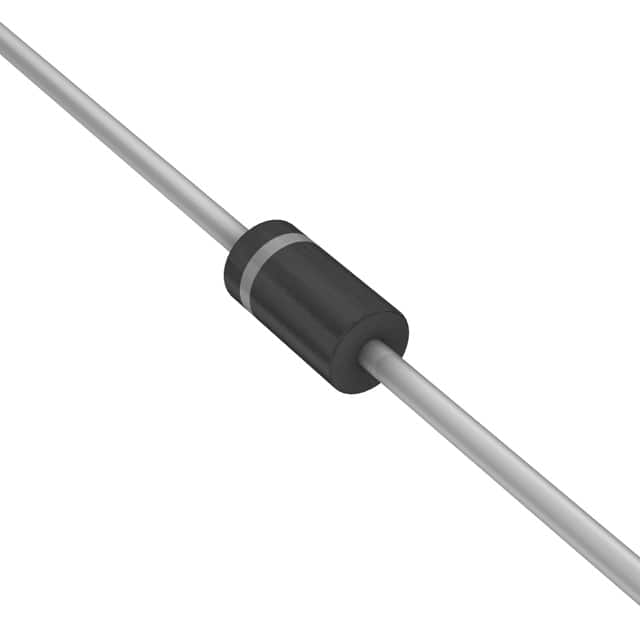Viz Specifikace pro podrobnosti o produktu.

MBR160 Diode: Encyclopedia Entry
Introduction
The MBR160 diode is a crucial component in electronic circuits, belonging to the category of Schottky diodes. This entry provides an overview of the MBR160 diode, including its basic information, specifications, pin configuration, functional features, advantages and disadvantages, working principles, application field plans, and alternative models.
Basic Information Overview
- Category: Schottky diode
- Use: Rectification and voltage clamping in electronic circuits
- Characteristics: High current capability, low forward voltage drop, fast switching speed
- Package: TO-220AC
- Essence: Semiconductor device for power rectification
- Packaging/Quantity: Typically available in reels or tubes containing multiple units
Specifications
- Voltage Rating: 60V
- Current Rating: 1A
- Forward Voltage Drop: 0.58V at 1A
- Reverse Leakage Current: 0.5mA at 60V
- Operating Temperature Range: -65°C to 125°C
Detailed Pin Configuration
The MBR160 diode has a standard TO-220AC package with three pins: 1. Anode (A) 2. Cathode (K) 3. Thermal pad (T)
Functional Features
- High current capability allows for efficient power rectification
- Low forward voltage drop minimizes power loss
- Fast switching speed enables rapid response in electronic circuits
Advantages and Disadvantages
Advantages
- Efficient power rectification
- Low power loss due to low forward voltage drop
- Fast response time
Disadvantages
- Limited maximum voltage and current ratings compared to other diode types
- Higher cost compared to standard silicon diodes
Working Principles
The MBR160 diode operates based on the Schottky barrier principle, where the metal-semiconductor junction results in a lower forward voltage drop compared to conventional PN-junction diodes. When forward-biased, the diode allows current flow with minimal voltage drop, making it suitable for high-frequency applications and power rectification.
Detailed Application Field Plans
The MBR160 diode finds extensive use in various electronic applications, including: - Switching power supplies - Voltage clamping circuits - Reverse polarity protection - DC-DC converters - Solar panel bypass diodes
Detailed and Complete Alternative Models
Several alternative models to the MBR160 diode include: - MBR120: Lower voltage rating (20V) and current capability (1A) - MBR2045: Higher voltage rating (45V) and current capability (20A) - MBR3060: Higher voltage rating (60V) and current capability (30A)
In conclusion, the MBR160 diode serves as a critical component in electronic circuits, offering efficient power rectification, low forward voltage drop, and fast switching speed. Its application spans across various fields, and while it has limitations, alternative models provide flexibility in design and performance.
Word Count: 368
Seznam 10 běžných otázek a odpovědí souvisejících s aplikací MBR160 v technických řešeních
Sure, here are 10 common questions and answers related to the application of MBR160 in technical solutions:
What is MBR160?
- MBR160 is a type of membrane bioreactor (MBR) system used for wastewater treatment.
How does MBR160 work?
- MBR160 uses a combination of biological treatment and membrane filtration to remove contaminants from wastewater.
What are the key benefits of using MBR160?
- MBR160 offers high-quality effluent, small footprint, and reduced sludge production compared to conventional wastewater treatment systems.
What are the typical applications of MBR160?
- MBR160 is commonly used in municipal wastewater treatment, industrial wastewater treatment, and decentralized water reuse applications.
What maintenance is required for MBR160?
- Regular membrane cleaning and inspection are essential for maintaining the performance of MBR160 systems.
Is MBR160 suitable for treating high-strength industrial wastewater?
- Yes, MBR160 is capable of effectively treating high-strength industrial wastewater due to its robust treatment capabilities.
Can MBR160 be integrated with other treatment processes?
- Yes, MBR160 can be integrated with additional treatment processes such as disinfection or advanced nutrient removal to meet specific treatment requirements.
What are the energy requirements of MBR160?
- MBR160 typically requires moderate energy input for aeration and membrane operation, but advancements in technology have led to more energy-efficient designs.
Does MBR160 require skilled operators to run?
- While MBR160 systems do require some level of expertise to operate, modern designs often include automated controls to simplify operation and monitoring.
Are there any limitations to using MBR160 in certain environments?
- MBR160 may face challenges in extremely cold climates due to the potential for membrane freezing, but this can be mitigated through proper system design and insulation.
I hope these questions and answers provide a good overview of the application of MBR160 in technical solutions! If you have any further questions, feel free to ask.

